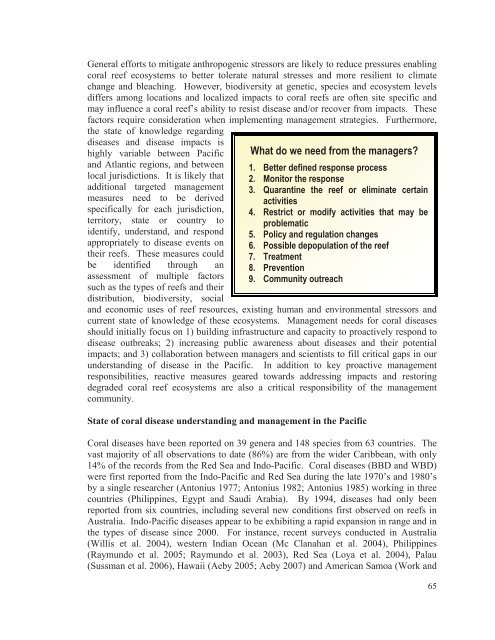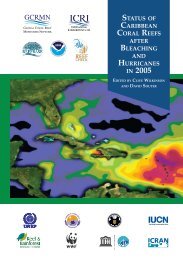Coral Health and Disease in the Pacific: Vision for Action
Coral Health and Disease in the Pacific: Vision for Action
Coral Health and Disease in the Pacific: Vision for Action
Create successful ePaper yourself
Turn your PDF publications into a flip-book with our unique Google optimized e-Paper software.
General ef<strong>for</strong>ts to mitigate anthropogenic stressors are likely to reduce pressures enabl<strong>in</strong>gcoral reef ecosystems to better tolerate natural stresses <strong>and</strong> more resilient to climatechange <strong>and</strong> bleach<strong>in</strong>g. However, biodiversity at genetic, species <strong>and</strong> ecosystem levelsdiffers among locations <strong>and</strong> localized impacts to coral reefs are often site specific <strong>and</strong>may <strong>in</strong>fluence a coral reef’s ability to resist disease <strong>and</strong>/or recover from impacts. Thesefactors require consideration when implement<strong>in</strong>g management strategies. Fur<strong>the</strong>rmore,<strong>the</strong> state of knowledge regard<strong>in</strong>gdiseases <strong>and</strong> disease impacts ishighly variable between <strong>Pacific</strong><strong>and</strong> Atlantic regions, <strong>and</strong> betweenlocal jurisdictions. It is likely thatadditional targeted managementmeasures need to be derivedspecifically <strong>for</strong> each jurisdiction,territory, state or country toidentify, underst<strong>and</strong>, <strong>and</strong> respondappropriately to disease events on<strong>the</strong>ir reefs. These measures couldbe identified through anassessment of multiple factorssuch as <strong>the</strong> types of reefs <strong>and</strong> <strong>the</strong>irdistribution, biodiversity, socialWhat do we need from <strong>the</strong> managers?1. Better def<strong>in</strong>ed response process2. Monitor <strong>the</strong> response3. Quarant<strong>in</strong>e <strong>the</strong> reef or elim<strong>in</strong>ate certa<strong>in</strong>activities4. Restrict or modify activities that may beproblematic5. Policy <strong>and</strong> regulation changes6. Possible depopulation of <strong>the</strong> reef7. Treatment8. Prevention9. Community outreach<strong>and</strong> economic uses of reef resources, exist<strong>in</strong>g human <strong>and</strong> environmental stressors <strong>and</strong>current state of knowledge of <strong>the</strong>se ecosystems. Management needs <strong>for</strong> coral diseasesshould <strong>in</strong>itially focus on 1) build<strong>in</strong>g <strong>in</strong>frastructure <strong>and</strong> capacity to proactively respond todisease outbreaks; 2) <strong>in</strong>creas<strong>in</strong>g public awareness about diseases <strong>and</strong> <strong>the</strong>ir potentialimpacts; <strong>and</strong> 3) collaboration between managers <strong>and</strong> scientists to fill critical gaps <strong>in</strong> ourunderst<strong>and</strong><strong>in</strong>g of disease <strong>in</strong> <strong>the</strong> <strong>Pacific</strong>. In addition to key proactive managementresponsibilities, reactive measures geared towards address<strong>in</strong>g impacts <strong>and</strong> restor<strong>in</strong>gdegraded coral reef ecosystems are also a critical responsibility of <strong>the</strong> managementcommunity.State of coral disease underst<strong>and</strong><strong>in</strong>g <strong>and</strong> management <strong>in</strong> <strong>the</strong> <strong>Pacific</strong><strong>Coral</strong> diseases have been reported on 39 genera <strong>and</strong> 148 species from 63 countries. Thevast majority of all observations to date (86%) are from <strong>the</strong> wider Caribbean, with only14% of <strong>the</strong> records from <strong>the</strong> Red Sea <strong>and</strong> Indo-<strong>Pacific</strong>. <strong>Coral</strong> diseases (BBD <strong>and</strong> WBD)were first reported from <strong>the</strong> Indo-<strong>Pacific</strong> <strong>and</strong> Red Sea dur<strong>in</strong>g <strong>the</strong> late 1970’s <strong>and</strong> 1980’sby a s<strong>in</strong>gle researcher (Antonius 1977; Antonius 1982; Antonius 1985) work<strong>in</strong>g <strong>in</strong> threecountries (Philipp<strong>in</strong>es, Egypt <strong>and</strong> Saudi Arabia). By 1994, diseases had only beenreported from six countries, <strong>in</strong>clud<strong>in</strong>g several new conditions first observed on reefs <strong>in</strong>Australia. Indo-<strong>Pacific</strong> diseases appear to be exhibit<strong>in</strong>g a rapid expansion <strong>in</strong> range <strong>and</strong> <strong>in</strong><strong>the</strong> types of disease s<strong>in</strong>ce 2000. For <strong>in</strong>stance, recent surveys conducted <strong>in</strong> Australia(Willis et al. 2004), western Indian Ocean (Mc Clanahan et al. 2004), Philipp<strong>in</strong>es(Raymundo et al. 2005; Raymundo et al. 2003), Red Sea (Loya et al. 2004), Palau(Sussman et al. 2006), Hawaii (Aeby 2005; Aeby 2007) <strong>and</strong> American Samoa (Work <strong>and</strong>65
















